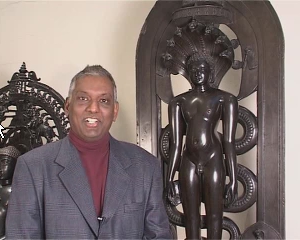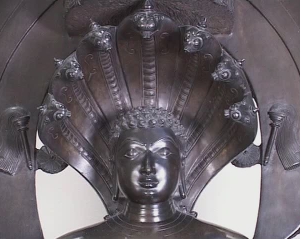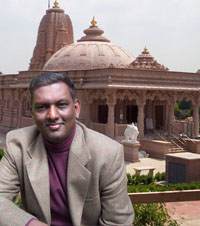 Hi. My name is Dr. Atul Shah. I live in Colchester in England and I have been in this country for 25 years. I was born as a Jain in Mombasa in Kenya and I was fortunate to be around and very close to one of the first Jain temples outside India in Mombasa and my father was very active in the community and that's where my love for Jainism began and grew. I was the founding editor of the only global international Jain magazine called Jain Spirit and today I am truly honoured to be at the Victoria and Albert Museum to talk about one of my favourite pieces - about Parshvanatha.
Hi. My name is Dr. Atul Shah. I live in Colchester in England and I have been in this country for 25 years. I was born as a Jain in Mombasa in Kenya and I was fortunate to be around and very close to one of the first Jain temples outside India in Mombasa and my father was very active in the community and that's where my love for Jainism began and grew. I was the founding editor of the only global international Jain magazine called Jain Spirit and today I am truly honoured to be at the Victoria and Albert Museum to talk about one of my favourite pieces - about Parshvanatha.
Lord Parshvanatha was the 23rd Tirthankara of Jainism, the 23rd prophet and this particular piece is very beautifully executed. As you can see, it looks like a perfect finish and what is to me the most attractive part of this piece is the posture of Lord Parshvanatha. I was fortunate to have learned yoga from the great living yoga master Sri B. K. S. Iyengar who has made a lot of emphasis on the standing posture. Now most of us stand and think that there is nothing in it, in the way we stand. But standing itself and standing in the right way with perfect balance, with the sense of equipoise, is actually an art. It needs to be crafted, it needs to be understood. And he would spend half an hour teaching us just the standing posture. And one of the quotes he made which still ring to me is that every cell in the body needs to be balanced. And when I look at this sculpture I feel that the person who carved this sculpture had that balance in mind. Understood the body, understood the anatomy of the human body and knew how important it was to have balance and equipoise.
This posture is known as the causal posture in the Jain scriptures and it is very important in many rituals. It is said that when the Tirthankaras meditated they sometimes stood in this position, not for a day, not for a week, but for months on end. It's very, very difficult for us to imagine or believe how that could be possible. But when I look at something like this is seems that if you have balance, if you have a sense of perfect balance, you can stand. Because you are in harmony with the force of gravity, you're in harmony with your inner self, you are at peace with your inner self and then you can stand. And those are the kinds of values about Jainism which I feel are so important in the 21st century, the value of inner balance, the value of alertness, because this sculpture also reminds me about alertness. It is a meditative posture, yet it is highly alert. So we need to be alert in society, we need to be conscious and peaceful at the same time. And those are the qualities we need to aspire to.
 What is fascinating about this piece, looking at it from a 21st century eye, is that we have a snake, a cobra, protecting our Lord Parshvanatha. Now today we have very little direct experience of snakes and what we know about cobras is that they are poisonous. They don't seem to have any positive quality, but they are poisonous and why is it that a snake that is so poisonous is protecting our most austere and spiritual Lord Parshvanatha? It think there is a message there and this is a message of the triumph of love over evil. I do believe that there is no one person who is 100% evil.
What is fascinating about this piece, looking at it from a 21st century eye, is that we have a snake, a cobra, protecting our Lord Parshvanatha. Now today we have very little direct experience of snakes and what we know about cobras is that they are poisonous. They don't seem to have any positive quality, but they are poisonous and why is it that a snake that is so poisonous is protecting our most austere and spiritual Lord Parshvanatha? It think there is a message there and this is a message of the triumph of love over evil. I do believe that there is no one person who is 100% evil.
A cobra is not 100% evil. It will only bite us when it is afraid or when it is scared. Otherwise it will leave us alone. And here it is protecting and giving shelter to a meditating Lord Parshvanatha.
There is also something else which I find intriguing about this sculpture and if you look closely, the snake is actually around the body of Lord Parshvanatha and then the hood is protecting. Now in reality, if we are meditating in a standing position, for months at a time, we need the forces of nature to keep us standing and here it seems that the cobra is actually providing another very useful function which is to actually keep Lord Parshvanatha standing. And we see this iconography in other arenas like Lord Bahubali, the famous sculpture in Southern India. A 56-foot majestic sculpture where he is standing in meditation again for months at a time and creepers are growing on top of him. I see that nature is actually protecting the pure and spiritual intentions of Lord Parshvanatha.
I myself have experienced, whenever I have committed my heart and soul to something, nature rises to protect me. It also gives me the strength, it is gives me the courage to go forward and I feel that this is also reminding us of the beauty of nature. Provided we do things in harmony with nature.
The hood is the head of the cobra of Dharanendra Padmavati and the hood is rising on top of the head to protect the meditative Lord Parshvanatha. All the Tirthankara's had always meditated outdoors in nature and it is a bit like an umbrella to protect against the hot sun or the rain and this is where there is a protection of nature for a right purpose.



 Dr. Atul Keshavji Shah
Dr. Atul Keshavji Shah

